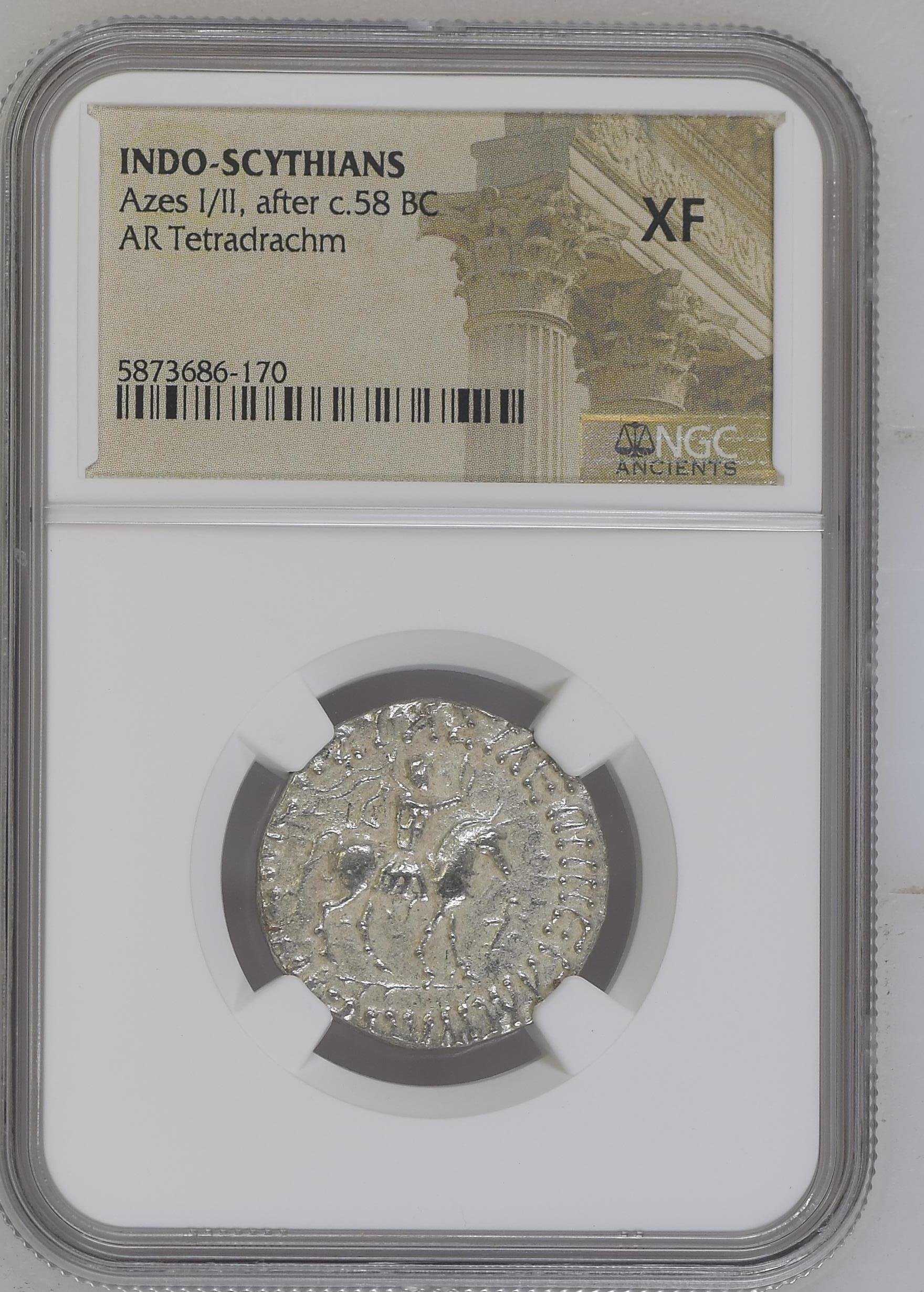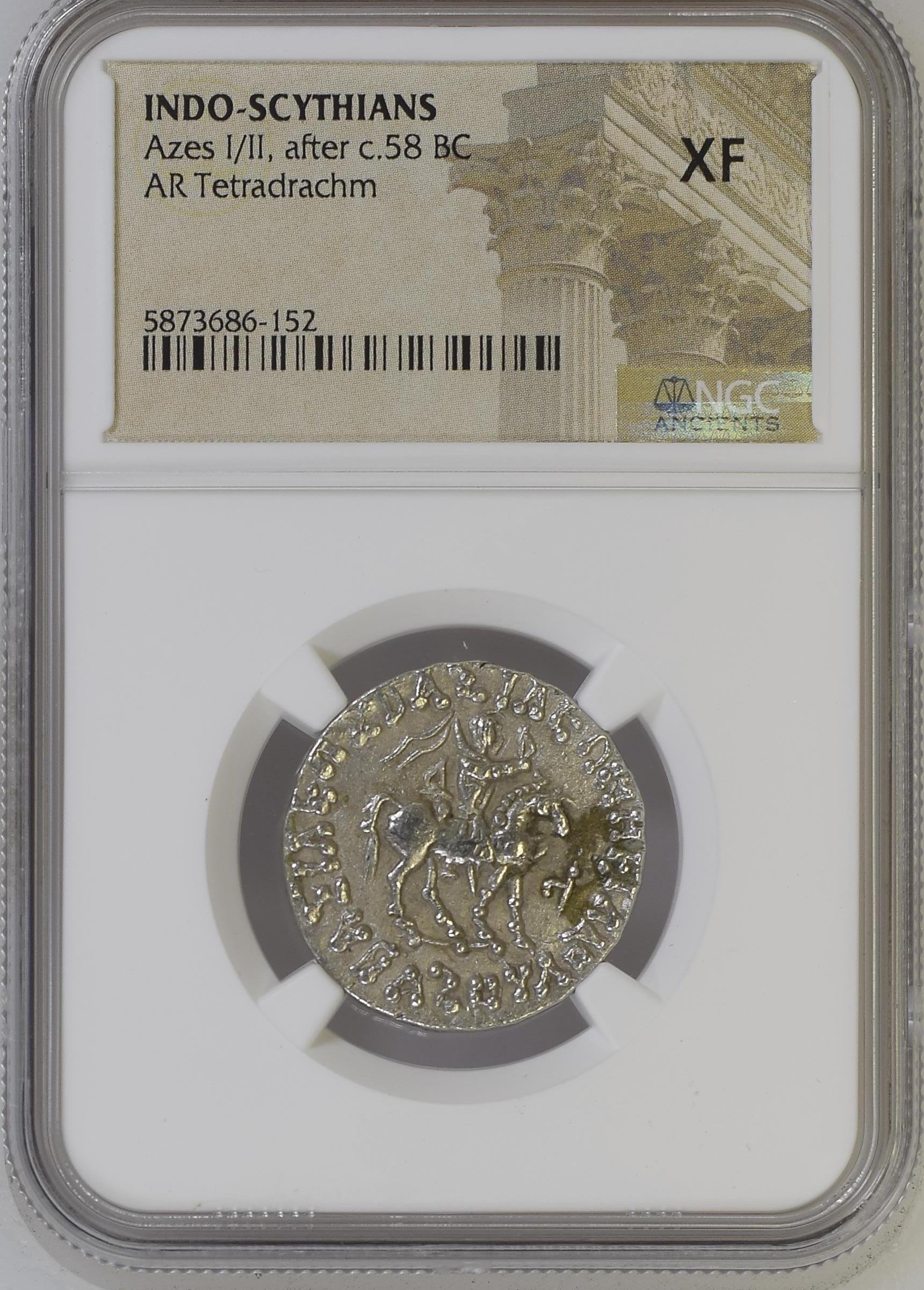 Image 1 of 2
Image 1 of 2

 Image 2 of 2
Image 2 of 2



Silver Tetradrachm of King Azes (about 2,080 years ago)
This is another example of a silver tetradrachm from the Indo-Scythian Kingdom under King Azes I or II, minted after approximately 58 BCE. The Indo-Scythians were nomadic warriors descended from the Sakas who migrated from Central Asia to establish control over parts of the former Greco-Bactrian and Indo-Greek territories. This large silver coin exemplifies the multicultural character of this historical frontier region.
Coin Description:
Front side: The obverse typically depicts King Azes on horseback, holding a spear or whip, with Greek-style inscriptions proclaiming him "BASILEOS BASILEON MEGALOU AZOU" (Great King of Kings Azes).
Back side: The reverse usually shows a standing deity, either the Indian goddess Lakshmi or a Greek goddess like Athena or Nike, holding symbols of victory. The inscriptions would be in Kharoshthi script, an ancient writing system used in Gandhara.
Technical Details:
Silver composition (AR)
Tetradrachm denomination (a substantial coin equal to four drachms)
Weight: Approximately 9-10 grams
Size: Approximately 25-30mm in diameter
NGC Grade: XF (Extremely Fine) - indicating excellent preservation with minor wear
Date of minting: After circa 58 BCE (late 1st century BCE to early 1st century CE)
Historical Significance: These coins were minted during a period of complex political transitions in ancient South Asia. Following the collapse of Indo-Greek kingdoms, Indo-Scythian rulers like Azes adapted Greek monetary systems while incorporating local cultural elements. The bilingual nature of their coinage—Greek on one side, Kharoshthi on the other—reflects their pragmatic approach to ruling a diverse population. These coins circulated widely in regions corresponding to modern Pakistan and northwestern India, facilitating trade along critical branches of the Silk Road connecting China to the Mediterranean world.
This is another example of a silver tetradrachm from the Indo-Scythian Kingdom under King Azes I or II, minted after approximately 58 BCE. The Indo-Scythians were nomadic warriors descended from the Sakas who migrated from Central Asia to establish control over parts of the former Greco-Bactrian and Indo-Greek territories. This large silver coin exemplifies the multicultural character of this historical frontier region.
Coin Description:
Front side: The obverse typically depicts King Azes on horseback, holding a spear or whip, with Greek-style inscriptions proclaiming him "BASILEOS BASILEON MEGALOU AZOU" (Great King of Kings Azes).
Back side: The reverse usually shows a standing deity, either the Indian goddess Lakshmi or a Greek goddess like Athena or Nike, holding symbols of victory. The inscriptions would be in Kharoshthi script, an ancient writing system used in Gandhara.
Technical Details:
Silver composition (AR)
Tetradrachm denomination (a substantial coin equal to four drachms)
Weight: Approximately 9-10 grams
Size: Approximately 25-30mm in diameter
NGC Grade: XF (Extremely Fine) - indicating excellent preservation with minor wear
Date of minting: After circa 58 BCE (late 1st century BCE to early 1st century CE)
Historical Significance: These coins were minted during a period of complex political transitions in ancient South Asia. Following the collapse of Indo-Greek kingdoms, Indo-Scythian rulers like Azes adapted Greek monetary systems while incorporating local cultural elements. The bilingual nature of their coinage—Greek on one side, Kharoshthi on the other—reflects their pragmatic approach to ruling a diverse population. These coins circulated widely in regions corresponding to modern Pakistan and northwestern India, facilitating trade along critical branches of the Silk Road connecting China to the Mediterranean world.
This is another example of a silver tetradrachm from the Indo-Scythian Kingdom under King Azes I or II, minted after approximately 58 BCE. The Indo-Scythians were nomadic warriors descended from the Sakas who migrated from Central Asia to establish control over parts of the former Greco-Bactrian and Indo-Greek territories. This large silver coin exemplifies the multicultural character of this historical frontier region.
Coin Description:
Front side: The obverse typically depicts King Azes on horseback, holding a spear or whip, with Greek-style inscriptions proclaiming him "BASILEOS BASILEON MEGALOU AZOU" (Great King of Kings Azes).
Back side: The reverse usually shows a standing deity, either the Indian goddess Lakshmi or a Greek goddess like Athena or Nike, holding symbols of victory. The inscriptions would be in Kharoshthi script, an ancient writing system used in Gandhara.
Technical Details:
Silver composition (AR)
Tetradrachm denomination (a substantial coin equal to four drachms)
Weight: Approximately 9-10 grams
Size: Approximately 25-30mm in diameter
NGC Grade: XF (Extremely Fine) - indicating excellent preservation with minor wear
Date of minting: After circa 58 BCE (late 1st century BCE to early 1st century CE)
Historical Significance: These coins were minted during a period of complex political transitions in ancient South Asia. Following the collapse of Indo-Greek kingdoms, Indo-Scythian rulers like Azes adapted Greek monetary systems while incorporating local cultural elements. The bilingual nature of their coinage—Greek on one side, Kharoshthi on the other—reflects their pragmatic approach to ruling a diverse population. These coins circulated widely in regions corresponding to modern Pakistan and northwestern India, facilitating trade along critical branches of the Silk Road connecting China to the Mediterranean world.
Azes II (Greek: Ἄζης ‹See RfD› Azēs, epigraphically ΑΖΟΥ ‹See RfD› Azou; Kharosthi: 𐨀𐨩 ‹See RfD› A-ya, ‹See RfD› Aya[1]), may have been the last Indo-Scythian king, speculated to have reigned circa 35–12 BCE, in what is Pakistan today. His existence has been questioned; if he did not exist, artefacts attributed to his reign, such as coins, are likely to be those of Azes I.[2]
After the death of Azes II, the rule of the Indo-Scythians in northwestern India and Pakistan finally crumbled with the conquest of the Kushans, one of the five tribes of the Yuezhi who had lived in Bactria for more than a century, and who were then expanding into India to create a Kushan Empire. Soon after, the Parthians invaded from the west. Their leader Gondophares temporarily displaced the Kushans and founded the Indo-Parthian Kingdom that was to last until the middle of the 1st century CE. The Kushans ultimately regained northwestern India circa 75 CE, where they were to prosper for several centuries.
Azes's name is attested on his coins in the Greek form ‹See RfD› Azēs (Ἄζης) and the Kharosthi form ‹See RfD› Aya (𐨀𐨩),[1] which are both derived from the Saka name *Aza, meaning "leader".[3]








